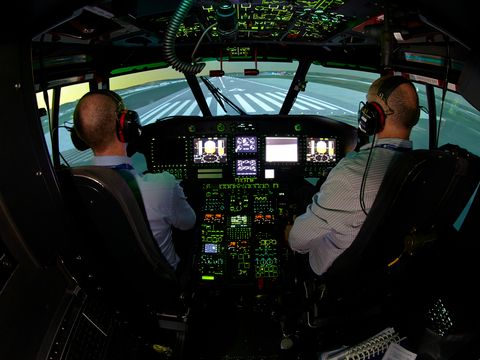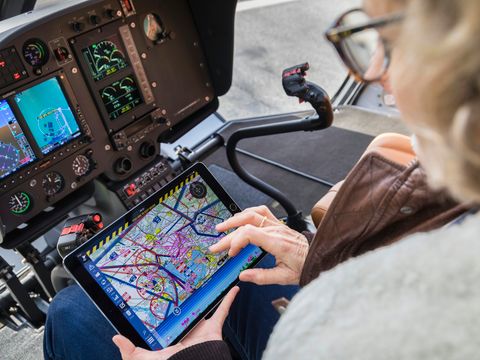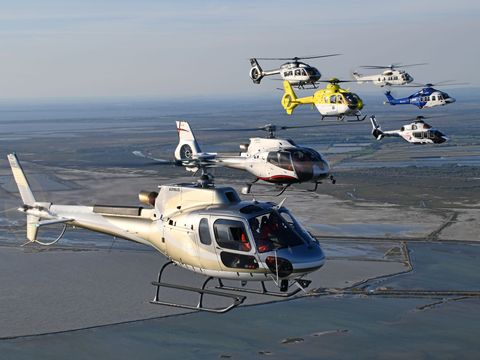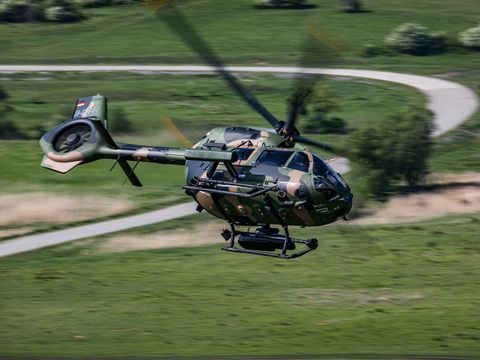Introduction
Efficient operations are directly linked to the proficiency of pilots, flight crew and technicians, as well as their ability to safely operate and maintain rotorcraft in a full range of conditions and missions. Airbus Helicopters provides comprehensive flight training solutions, including both pre-entry level and mission-oriented modules, allowing pilots to complete standard type rating certification. Our instructors are continuously working hand-in-hand with customers to identify and implement the best training solutions.

AB Initio
Ab-Initio (VFR / IFR on request)
Ab-Initio courses available upon request: EASA, non EASA, and tailored solutions
Available from Private Pilot License (PPL H) to Commercial Pilot License (CPL (H)IR (in flight qualification) - Theoretical Airline Transport Pilot License (ATPL H)
The team will support and set, through a partnership, the best solution suited to their needs and will accompany them throughout the process.
- Qualification: from dedicated non-certifying training (military) to certified (i.e. EASA) PPL (H), CPL (H) - IR (Instrument Rating).
- Duration: from 6 to 18 months (exact duration to be defined according to pilot's needs
- Delivered at Airbus Helicopters' partners' facilities
Bridge courses
Pre-Entry Level Turbine Engine
This introductory module is a prerequisite for pilots qualified on helicopters with piston engines who seek qualification on turbine engine-powered rotorcraft. As an addition to the initial type rating course, it provides the required knowledge on normal/emergency turbine operations and governing.
Pre-Entry Level Multi-Engine
This three-day course is a prerequisite for pilots qualified on single-engine helicopters who seek qualification on a multi-engine rotorcraft. It focuses on normal/emergency procedures, system and regulation, flight planning and operational procedures/performance.
Pre-Entry Level Multi-Crew Cooperation
This course is a prerequisite for pilots qualified to fly single pilot operations seeking qualification to fly mulit-pilot operations.
Teaching and Learning
This one-week immersion course provides a special focus on technical vocabulary in preparation for a type rating certification in the English language. The class is recommended for pilots who scored 30-45% on their online English self-assessment.
Type Rating
Initial Type Rating
Approved by many national authorities, the Initial Type Rating course provides the knowledge and proficiency necessary to acquire a first type rating on a new helicopter family.
This course is available on a turbine engine, single engine turbine, multi-engine turbine, single pilot or multi-pilot helicopter.
Additional Type Rating
This course provides an additional type rating within the same category: single-engine turbine, multi-engine turbine, single-pilot or multi-pilot helicopters.
Combined Multi-Crew Cooperation Type Rating
The course is an initial type rating course for IR multi-pilot (MP) / multi engine (ME) with combined multi-crew cooperation.
Difference Type Rating
This course allows pilots to acquire an additional type rating on another aircraft of the same family for which they already are qualified.
Instrument Rating
The Instrument Rating course provides non-EASA pilots the knowledge and proficiency needed for IFR (Instrument Flight Rules).
Reduced Type Rating (H160 only)
This is an optimised Part-FCL course dedicated to H175 type rated pilots.
With pilot knowledge pertaining to the H175 and H160 commonaliies (autopilot, FMS, and Helionix sytem), the trainee can access an optmised training experience focusing only on H160 specifications.
Reduced Type Rating (H160 only)
This is an optimised Part-FCL course dedicated to H175 type rated pilots.
With pilot knowledge pertaining to the H175 and H160 commonaliies (autopilot, FMS, and Helionix sytem), the trainee can access an optmised training experience focusing only on H160 specifications.
Type Rating Examiner (TRE)
This course is an examiner standardisation course designed for helicopter pilots who want to get their first TRE (H) (Initial Type Rating Examiner course) qualification.
Type Rating Instructor (TRI) / Synthetic Flight Instructor (SFI) / Flight Instructor (FI)
1) The approved Type Rating Instructor (TRI) and Synthetic Flight Instructor (SFI) course provides the necessary skills for a helicopter license holder to deliver, revalidate or renew a type rating on an aircraft.
2) This approved course is designed for helicopter pilots already qualified as type rating instructor on a specific helicopter type, who would like to extend their TRI(H) privileges on the same helicopter type or to extend their TRI(H) privileges to another type of helicopter.
Blended Learning
Blended learning available for some type rate courses.
Blended learning combines both virtual and in-person learning. Theoretical classes that can be either fully or partially virtual, and are completed with on-site practical sessions combining the advantages of a physical class and that of a virtual classroom environment.
Additional Training
VFR pilot to IFR pilot
The VFR pilot to IFR pilot course is intended for non-IR qualified pilots who would like to acquire the basic knowledge
and skills needed to safely conduct a complete flight in instrument meteorological conditions (IMC) using their own
operating procedures. At the end of the course, the pilot will be able to prepare and safely conduct a complete flight in IMC.
AFCS Garmin
The objective of the AFCS GARMIN course is to familiarise the pilot with the H125 Garmin AFCS. The pilot will learn how to manage stabilisation mode and the upper mode of the GMC 600H.
Garmin Familiarisation
This course is designed to familiarise pilots with the Ecureuil range of avionics, Garmin G500H and G500H TXi suites, who are already type rated on Ecureuil helicopters. The practical part of this course is carried out on the helicopter or on the Garmin emulator system application.
Role Training
External Load
Initial and conversion to type (CTT) training courses for sling external load operation are available for pilots, ground staff (GS) and rear crew members (RCM).
The aim of the initial training course is to deliver mission capability when trainees are already mission capable on another type of helicopter and need to be trained on a new helicopter for the external load mission.
Hoist Operations (Pilot & HHO)
The Initial Hoist Training course provides the knowledge and proficiency to execute an onshore hoist mission with a high level of safety and great efficiency.
SAR Equipment
This course is designed for pilots qualified on a specific type/variant who would like to conduct SAR upper mode hoist operations.
Night Vision Goggles (NVG) - 3 levels
Night Vision Goggles (NVG) preparation is divided into three levels.
1. NVG Pre-Entry is a day-long theory-based course that provides pilots with the foundations needed to safely pilot an aircraft with NVG.
2. NVG Level 1 is intended for pilots who would like to become proficient with NVG in familiar terrain.
3. NVG Level 2 is focused on proficiency in unfamilar terrain.
Firefighting
The firefighting course focuses on fire behaviour, piloting techniques and mission equipment. It includes a ground course, a long briefing and a flight session. To join the course, the pilot needs to complete the external load course and Helicopter Underwater Escape Training.
Maintenance Check Flight (Section 8)
This course is designed to give proficiency on maintenance check flights as required by Section 8 of the flight manual, focusing on normal/emergency situations, parameter check performances and piloting techniques. It includes one day of theory, and a flight or simulator session.
Rig'N Fly
The objective of the course is to provide knowledge regarding the offshore sector and to learn the Rig'N Fly function, a Flight Management System that is dedicated to oil rig platform approaches in degraded visual environments.
Mountain Flight
The content and level of this course is personalised according to the pilot’s experience. At the end of this course, the pilot will be able to understand the operational environment and adapt the trajectory, as well as safely continue training in the normal operational environment.
Refresher Training
Recurrent Emergency (classroom ground refresher & FSTD refresher)
A tailored programme that brings the customer’s operational expertise up to date and checks and renews their type rating in accordance with the licence proficiency check (LPC). The level of skills to be acquired is defined with the customer.
Seminar for TRI (Type Rating Instructor) - TRE (Type Rating Examiner)
Keep your knowledge and qualification up to date with seminars according to Part FCL requirements.
Type Rating Renewal
The Type Rating Renewal course updates the pilot's knowledge and proficiency needed to renew the type rating on a different aircraft, if the class or type rating has expired. The revalidation or renewal test extends the type rating according to PART FCL regulations.
Type Rating Revalidation
The purpose of this course is to update the customer’s knowledge and proficiency in order to revalidate the type rating on their aircraft according to the PART FCL regulations.

Safety Boost Module
The aim of the Safety Boost Module course is to enhance flight safety by reducing accident rates caused by poor visual conditions during flight. The course combines a refresher of the IIMC initial training part of the course, which is usually covered in a PPL or CPL(H) course, and an understanding of the causes of vortex.








